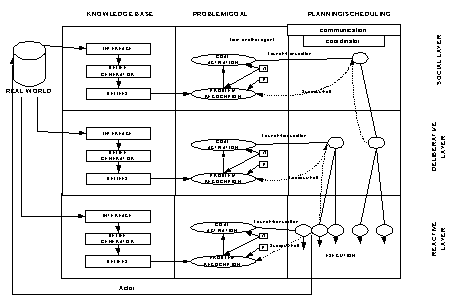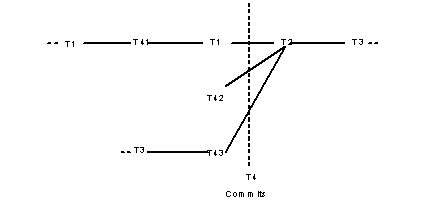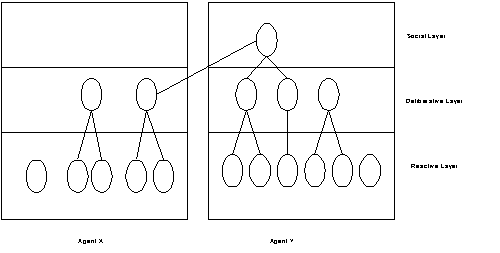

0227-B4
A.M Rasol 1
The reason for focusing to agent technology is because of the ever-growing complexity of forest information systems and the increasing difficulty to plan in a dynamically changing environment. Forest planning and scheduling problems, and database technology have for a long time realized to deal with the robustness by developing suitable technology, Decision Tree Learning on very large forestry data sets. In this paper an implementation model for agents with layered architecture in a tropical forest Selective Management System based on database infrastructure is proposed. The model overcomes the non-parallel in implementing the various agent processing functions together with the limitations imposed on concurrent execution of agent actions. An example is provided to illustrate how the various agent functions are imposed on concurrent execution of agent action using Conflict Resolution technique.
One of the motivations for focusing to agent technology is the increasing complexity of forest information systems and the increasing difficulty to predict and plan for dynamically changing environments. None of the forestry applications seems to use existing agent architectures and yield them as a subject of research. Three-directions of agent architectures have been developed over the past decades: reactive, deliberative, and coordinating architectures (Muller and Pischer 1993). Some research efforts have been contributed to the exploration of how hybridisation of these architectures as layered architectures (Fergusson 1992; Firby 1992).
In forestry applications, the main issue is robustness in environment that is prone to dynamically changing environments. On the other hand, is the issue that database technology has focused on by developing the concept of information theory (Shannon and Weaver, 1949). If one managed to combine databases and agents technologies, there should be a much better chance of employing layered agent architectures to forestry agent-based systems. These applications are large-scale systems that must ensure a high degree of reliability while maintaining high performance by executing concurrent decision trees. This paper involves the implementation model for applying layered agent architecture in forestry database environment. The implementation of the architecture is realized by all level of components with concurrent execution of agent actions and orthogonal implementations of agent functions in a decision trees (DT). In DT, all the reliable rules for parallel execution are defined. Contingency actions, in case of failure of some of the components of the plans, are also defined within the DT. A Decision Tree Model (DTM) will be employed to represent DT to ensure the degree of high concurrency in agent actions are increased before the contingency action is committed to the database infrastructure. Another advantage is that the addition of new functions to the agents does not require detail knowledge of original functions due to the capturing of plans together with their active state within the same DT.
The remainder of the paper is organized as follows. Section 2 presents the proposed intelligent agent layered architecture, the role of each layers in the aspects of agency, and describes the detail architecture components. Section 3 contains a case study in implementing a DTM typically to Selective Management System based on database infrastructure. Section 4 and section 5, gives the future works and conclusion respectively.
Here we present an intelligent agent architecture in an attempt to answer some of the shortcomings of existing forest information systems. Our architecture consists of: reactive layer, deliberative layer, social layer, knowledge base module, problem and goal module, and planning and scheduling module, forestry database, sensors, coordinator and communication interface.
In the following sections we will look closely at these components with the assistant of figure 2.1.
Figure 2.1: Agent Layered Architecture

The agent's perceptions (sensors) are translated into reading the database objects, while its actions are translated into performing write operations to these objects. Reading and writing are done within normal set of rules having atomic, consistent, and permanent properties (Ensor and Gabbe 1988). The agent's Knowledge Base (KB) is stored in a database at each agent layer. User Interfaces of the relevant information available in underlying layers are materialized. The belief generator of each layer acts as an interpreter and problem solver for automated reasoning uses its interface to update the agent's beliefs. These beliefs are stored in the knowledge base database of the corresponding layer.
The PG part of the agent contains the Problem identification (P) and Goal activation (G) modules. In light of the given goals at each layer, a goal is activated based on a chosen domain problem stored at this layer. The higher the layer is, the more complex are its plans and the more difficult it gets in representing them. Plans are to be modeled as DTM as will be shown later in Section 4.0. A goal can be activated only by the problem identification module of the corresponding layer of the agent or another agent in the case of the social layer.
In the context of the activation mechanisms the problem receives incompetence messages from the Planning and Scheduling (PS) module of the underlying layer of the architecture, whereas in the implementation model events that mainly influence the problem identification module are belief updates. The particular activation mechanism of the problem identification depends on the database infrastructure. An active database infrastructure is recommendable, which triggers the problem module with each new situation. Other kind of events to be monitored by the problem module is events that are the result of the activated goal on the same layer: the success/fail of the actions is returned from the PS module. In the social layer, some events coming from other agents through the communication interface. The PS module receives the success/fail results and other coordination messages of the agents incorporated in jointplans in which several agent collaborate in order to achieve a common goal (Lavesque et al. 1990). In the PS part of the agent, activated goals are realized by means of activities. In the next section, these activities are defined using a decision tree model.
Overall, the activities in the decision tree model are reflected by a number of decision nodes. Every decision node member is committed to achieving some goal while also believing the other decision node members are pursuing that goal. The decision node members exchange messages to update their mutual beliefs and synchronize their behaviour, establishing what is called joint commitment. In general, a decision node member cannot commit unless all its decisions are terminated. However, if one of the nodes fails, its parent nodes does not have to abort. It has the choice between: ignoring the unessential condition (node), reinstating the sub-node, activating another compensating sub-node , or abort.
The sub-node may commit or abort independently and appear atomic to other sub-node. Therefore, executing compensating node whose role is to mitigate the permanent effects of the original sub-node must compensate the other sub-node. By defining these sub-nodes, the goal of integrating the agent actions together with their active state within a DT.
Given this decision tree model, the procedures are managed as follows. The database infrastructure schedules the sub-nodes at each agent layer. The scheduler is responsible for identifying conflicting nodes and serializing them using locks specified in a Conflict Resolution (Martial 1992). Other responsibilities of the scheduler include possible deadlock detection and resolution. The generated schedule is then passed to the Execution level, which performs the agent actions on the forestry knowledge database in an efficient and reliable way.
At the lowest layer, the sub-nodes are simple DT framework. Operations involved are database read/write. At higher layers, operations become more abstract. This allows further exploitation of the semantics of the operations by commuting their execution on the basis of the predefined Conflict Resolution. The great advantage of this approach is the direct transformation of conflicts between various agent behaviors to a conflict of decision nodes on data, which is automatically handled by the database scheduler and require no direct and explicit analysis on a combinatorial basis.
When coordinating autonomous agents in order to enable their Social layers to satisfy their collaborative goals. That's why coordination at the social layer of one agent cannot initiate a sub-node at another agent. Another reason is that agents can be deployed in a heterogeneous environment, in which each agent operates on a different database infrastructure. The role of the Problem Identification and Goal Activation module is to coordinate between them using a protocol similar to the 2Phase Commit protocol (Ensor and Gabbe 1988). It uses the Communication Interface module, which is responsible for the exchange of messages between agents in conversation languages such as KQML (Finin et al. 1994) and FIPA 97 (FIPA 1998).
In this illustrative case study, it is required to build an agent that determines the forest treatment types and status of forest stand in a selected forest. The aim of this example is to demonstrate the ease of development of the agent in various functions. By using DTM, the degree of concurrency is largely increased; thus increasing the agent flexibility in executing its plans. The overhead of coordinating these concurrent actions is undertaken by the underlying database infrastructure. Moreover, due to the definition of the agent plans in the form of coordination, the plan is self-contained and includes the compensating actions, needed in case of failure of one or more the sub-nodes. This allows existing conflicts to be implicitly solved, avoiding a later explicit solution from the user.
The forest stand (S) has a current inventory data. The agent's plan is to process the inventory data allowing the best solution strategy for the user and, at the same time, recommending the user's needs. These needs include the following: (a)interpretation of forest inventory data, (b)needs for selective forest management system, and (c)collaborative forest planning operations
In this implementation, the fulfilling needs (a) will at first initiated and then expanding the system for further needs. From the DT, the independence in developing the various functions can be easily concluded. Forestry database consists of four basic objects: the forest stand object (F), the tree number (N), the tree diameter classes object (D), and tree species (S). A set of events that occur is the category for D classes >45cm, +30 - 45cm, +15 - 30cm) and the tree species types (Dipertocarps and Non-Dipterocarps).
Whereas the N and DBH are updated fairly regularly by interval tasks, the F and S remains locked for a whole period. This non-shared lock is then released for a certain period in which the new value to be locked is specified, and the lock is renewed for another period. For an outline of all operations see Figure 5.1. To implement (a) only the agent Reactive Layer is needed. The agent has a view of the Forest Resource (FR) i.e. forest inventory data having set of variables such as: tree number, tree species, and tree diameter. Its problem identification is simple: to analyse the FR using other software. Launching a simple orthogonal task T1 to update the F inventory data activates the corresponding goal, namely, a forest inventory analysis assignment. Another task, also launched from the agent Reactive Layer, is the classification assignments consisting the total number of trees per hectare, total volume per hectare according to tree diameter classes and tree species types.
Figure 5.1: Domain Problem Definitions

This plan, T2, determines the data set required for the needs of practicing selective management system of the Forest Stand. Problem (b) involve more deliberation. The place to implement it is at the agent Reasoning Layer, where the agent tries to fulfill more complicated goals. Usually, the user will observe the required management options and must be coordinated with getting the necessary variables from the existing FR. So, at this layer, the agent watches the type of expertise to get involved. When a good deal is observed by the situation recognition module, the goal "selection of management options" is activated and a DT is executed by initiating the root problem T3 at the deliberative layer to decide the necessary assignments. This root problem creates three sub-problems at the lower level: T31, T32, and T33. T31 updates the F (T31 is of the same type as T1). For example, T32 allocates the list of silviculture treatments by triggering the number of trees according to their conditions (i) diameter class >45cm, number of trees ≥ 25, number of Dominance trees ≥25, number of vine free trees ≥25, (ii) diameter class +30 - 45cm, number of trees ≥32, number of Dominance trees ≥32, number of no-climber trees ≥32, (iii) ) diameter class +15 - 30cm, number of trees ≥ 100, number of Dominance trees ≥100, number of no-climber trees ≥100. T33 waits until the release of the lock on the FR to make the final decision. Under the DT these sub-problems (T31, T32, and T33) can run concurrently with each other or with other problems. All the designer has to do is to define the appropriate behavior in case of failure of these problems according to the rules mentioned in Section 4.0 (e.g defining compensation node). Then, it is up to the database infrastructure to learn and execute these DT, resolve possible conflicts, and handle exceptions resulting from the failure of one the sub-problems. Figure 5.2 shows a semantically concurrent execution of these DT, expressed as a partial order between them. The graph proceeds from left to right and the edges mark the order between conflicting pairs of sub-problems.
Figure 5.2 A Semantically Concurrent Execution

The agent Social Layer is needed for satisfying collaborative needs (c). In this case, determining forest planning operations based on the forest stand inventoried area. At this layer, the agent has a view of the Forest Stand, and the rule set from the cutting regimes lists, silviculture treatments, and forest stand status observed by the Problem Identification. Also depending on who is to take the initiative, it observes activating messages from the other agent(s). When the opportunity comes, DT, similar to T3, are instantiated at the Reasoning Layer of both agents. Although, in principle, a single parent for both sub-problems is sufficient (see Figure 5.3), this is not allowed due to the autonomous nature of agents. A model having a parent (root) problem at the Social Layer of each agent (see Figure 5.4) and having a coordinator coordinating between these two root problems seems to be an appropriate solution.
Figure 5.3: Single node (one root) for nonautonomous agents

Figure 5.4: Loosely coupled node (two roots) for autonomous agents

The implementation model is a first step toward a full representation of agents layered architectures in terms of activities based on DT. The aim is to make use of the knowledge of decision semantics to increase degree of concurrency. This DTM opens the way for another aspects in their use, namely the representation of agent plans. By capturing the plans together with their active state within the same structure, they form a powerful tool for detecting and resolving conflicts in deliberative layer. However, further refinement and fine-tuning has to be done to the DTM to better serve its new purpose as a generic representation tool for the various planning strategies. The questions on what kind of planning strategies can be represented as DT, or conversely, how these can be adjusted to meet particular strategies.
In this paper, an attempt is made to complement agent technology with forestry database technology to increase system robustness. The decision trees model provides an independent implementation of agent operation. Representing agent plans in terms of DTM opens the door for a large degree of concurrency between agent actions, thus simplifying agent plans and at the same time without having the developer worrying about coordinating them. Additionally, a clearly defined DTM within a semantically concurrent execution provides a neat design and avoids much of the undesired negative interactions between the various agent actions.
Ensor, J.R., and J.D. Gabbe, 1988. Transactional blackboards. Readings in distributed artificial intelligence. Eds. Bond, A.H and Gasser, L. Morgan Kaufmann, California.
Fergusson, I.A., 1992. Touring Machines: An Architecture for Dynamic, Rational, Mobile Agents. Ph.D Thesis, Computer Laboratory, University of Cambridge, United Kingdom.
Firby, R.J., 1992. Building Symboliuc Primitives with Continous Control Routines. In.J.Hendler, editor. Proceeding of the 1 st International Conference Intelligence Planning Systems. Morgan Kaufmann.
Finin, T., R. Fritzon, D. Mckay, and R. McEntire, 1994. Draft specification of the KQML AgentCommunication Language. The DARPA Knowledge Sharing Initiative External Interfaces Working Group, Baltimore.
FIPA, 1998. Agent Communication Language. Foundation for Intelligent Physical Agents, Geneva, 1998. http://www.fipa.org.
Lavesque, H.J., P.R. Cohen, and J.H.T. Nunes, 1990. On acting together. Proceedings of the 8 th National Conference on Artificial Intelligence (AAAI-90), 94-99. Boston, MA:AAAI Press.
Martial, F. 1992. Coordinating plans of autonomous agents. Lecture notes in computer science 610, Springer Berlin.
Muller, J.P., and Pischel, M., 1993. The agent architecture inteRRaP: Concept and application. Research Report RR- 93-26, Deutsches Forschungszentrum fur Kunstliche Intelligenz, Kaiserslautern, Germany.
Shannon, C.E., and W. Weaver, 1949. Mathematical Theory of Communication, Urbana, IL:University of Illinois Press.
1 The author is a Research Officer with the Forest Research Institute Malaysia and currently doing his PhD as a Research Student, Centre of Computing Intelligence, De Monfort University, Leicester, United Kingdom.
Centre of Computing Intelligent
De Monfort University, Leicester, LE 1 9BH, UK
44-01162 577939
email: [email protected]